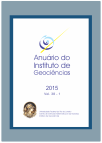Sodalite Cancrinite Nepheline Syenite of Mendanha Massif, State of Rio de Janeiro, Brazil, Called Commercially Blue Guanabara Granite, and its Origin from Deuteric Metasomatism
DOI:
https://doi.org/10.11137/2015_1_21_30Keywords:
Blue Guanabara Granite, Sodalite syenite, Natural stone, Deuteric metasomatismAbstract
This article reports field observations, petrographic descriptions, and genetic consideration on the sodalite cancrinite nepheline syenite, called commercially Blue Guanabara Granite, which is found in southwest contact of Mendanha felsic alkaline intrusion, State of Rio de Janeiro, Brazil. This natural stone occurs along the central axis of a syenitic dyke of 15 m in width. The whole-rock macroscopic colour is characterised by low saturation (S=5~7) and medium brightness (B~62). The opaque minerals colour has relatively high brightness (B~28). The alkaline feldspar is often altered into muscovite. The feldspathoids occur in the interstitial frameworks of alkaline feldspar. The amphibole and biotite are altered into opaque minerals and vermiculite, showing pseudomorph. The accessory minerals are primary magnetite and titanite. There is a significant amount of modal carbonates of 6.8%. The macroscopic colour of the feldspathoid aggregates ranges from deep blue to light blue according to the relative contents of sodalite. The sodalite and cancrinite are originated from nepheline and formed through Cl-rich fluid deuteric metasomatism.Downloads
Published
2017-02-15
Issue
Section
Article
License
This journal is licensed under a Creative Commons — Attribution 4.0 International — CC BY 4.0, which permits use, distribution and reproduction in any medium, provided the original work is properly cited.

















